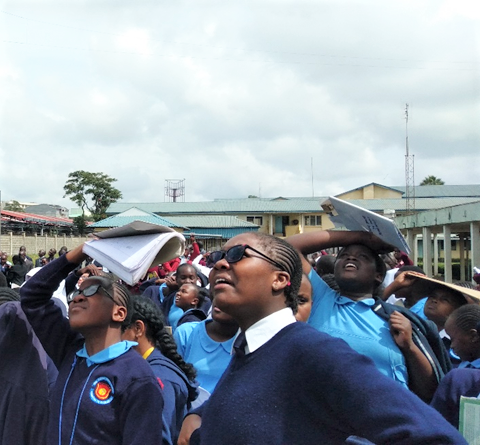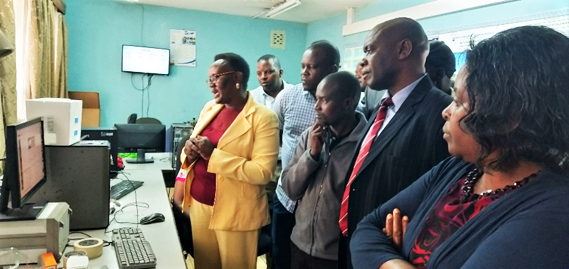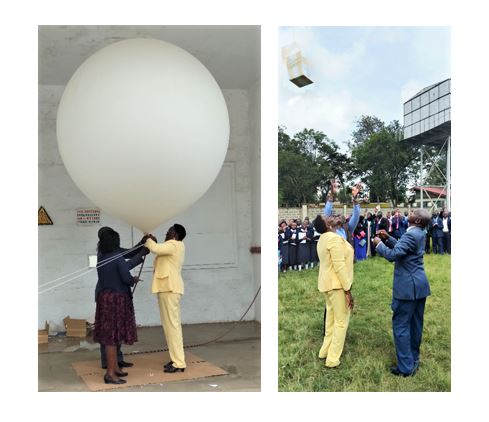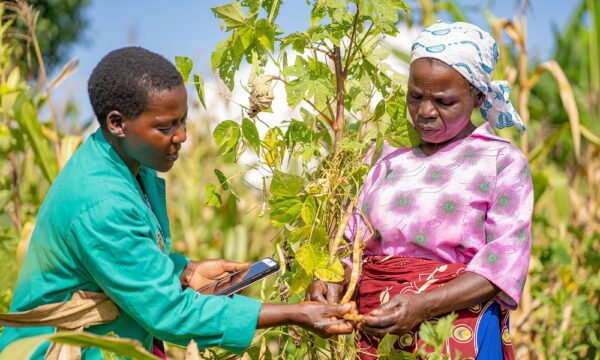
Around 250 students from the University of Nairobi, Manguo Secondary School and Visa Oshwal Primary School were part of a 400-strong crowd that gathered to witness the launch of a radiosonde packed with gadgetry as part of the UK Space Agency-funded* CABI-led Pest Risk Information Service (PRISE).
The students literally had their eyes on the radiosonde as Dr MaryLucy Oronje, SPS Manager based at CABI’s centre in Kenya, joined meteorologist Ms Annette Nyaga in launching a hydrogen-filled balloon up to 36 kms into the sky to collect climate data on rainfall, temperature, humidity and land surface temperature for scientists back on earth to validate.
The radiosonde, launched at the Kenya Meteorological Department (KMD) in Nairobi, Kenya, is a vital piece of scientific kit which helps with key weather data that in combination with earth observation technology, satellite positioning and plant-pest life-cycling PRISE uses to forecast the risk of pest outbreaks threatening the livelihoods of smallholder farmers as well as local and national food security.
Pests can decimate crops and are estimated to cause around a 40% loss. These insects, mites and plant pathogens not only impact on food security but also impede supply chains and international trade. PRISE aims to solve this problem by using data to help farmers manage pests as part of an Integrated Pest Management plan.

Ministers of Agriculture and their extension experts in Kenya, Zambia, Ghana and Malawi are actively engaged and involved in this pest forecasting system, which collects and combines disparate datasets, manipulates data using computational and modelling expertise, and leverages well-established international development networks.
In-country data on Fall armyworm on maize and tuta absoluta on tomatoes is collected from the field validation sites and fed into the model together with weather data. Risk messages and mitigation measures are communicated to users and is monitored and evaluated for the service to assess its impact.
Risk forecasts are also integrated into existing plant health systems, using networks in current programmes and projects, to trigger appropriate action and deliver large scale alerts, advice and inputs to farmers.

Dr Oronje said, “It was a sweet coincidence that at the planned launch of the radiosonde, a number of students were visiting the KMD for a ‘show and tell’ session on the weather and climate parameters including how they are measured. To witness the actual release of the big balloon with gadgets was an added premium to their visit.”

The radiosonde measures the vertical profile of meteorological variables (called a sounding) and transmits the data to a ground-based receiving and processing station. Ms Nyaga informed the CABI team that the KMD have weekly radiosonde launches where the preparations begin seven days before launch day. On the actual day another hour of final checks are carried out before the gas-filled balloon takes the instruments to the skies.
Dr Oronje added, “Having successfully released the radiosonde, we quickly went bac to the set-up room to see the reading. Daniel Wepukhulu, KMD PRISE leader reiterated that the balloon would be airborne for between two to three hours and up to 36kms into the sky. Back on the computer, the data on temperature and humidity etc kept trickling in as the radiosonde and the balloon rose higher and higher.”
Ms Nyaga added that after 35kms of height the balloon shatters and the instruments fall back to earth. As it is not always possible to control where the radiosonde lands, a note is written and placed inside giving information on what the gadget is and to whom it belongs. In this way anyone who picks it can understand what it is without panic or alarm.
“In the wake of climate change and its impacts in farming systems, KMD and other partners are providing crucial weather data and advice as part of the Pest Risk Information Service,” she said.

Additional information
Find out more about how the Pest Risk Information Service (PRISE), which is co-funded by Plantwise, is forecasting the risk of pest outbreaks, using a novel combination of earth observation technology, satellite positioning, and the plant-pest life cycle for sub-Saharan Africa. More information is also provided on the project’s other partners.
Related News & Blogs
Training delivered on early warning system using Earth Observation data to help manage crop pest pests in Kenya
CABI has teamed up with the Kenya Agricultural & Livestock Organization (KALRO) to deliver training aimed at helping smallholder maize, bean and tomato farmers understand important crop pest alerts derived from Earth Observation data. Experts in di…
30 April 2025




